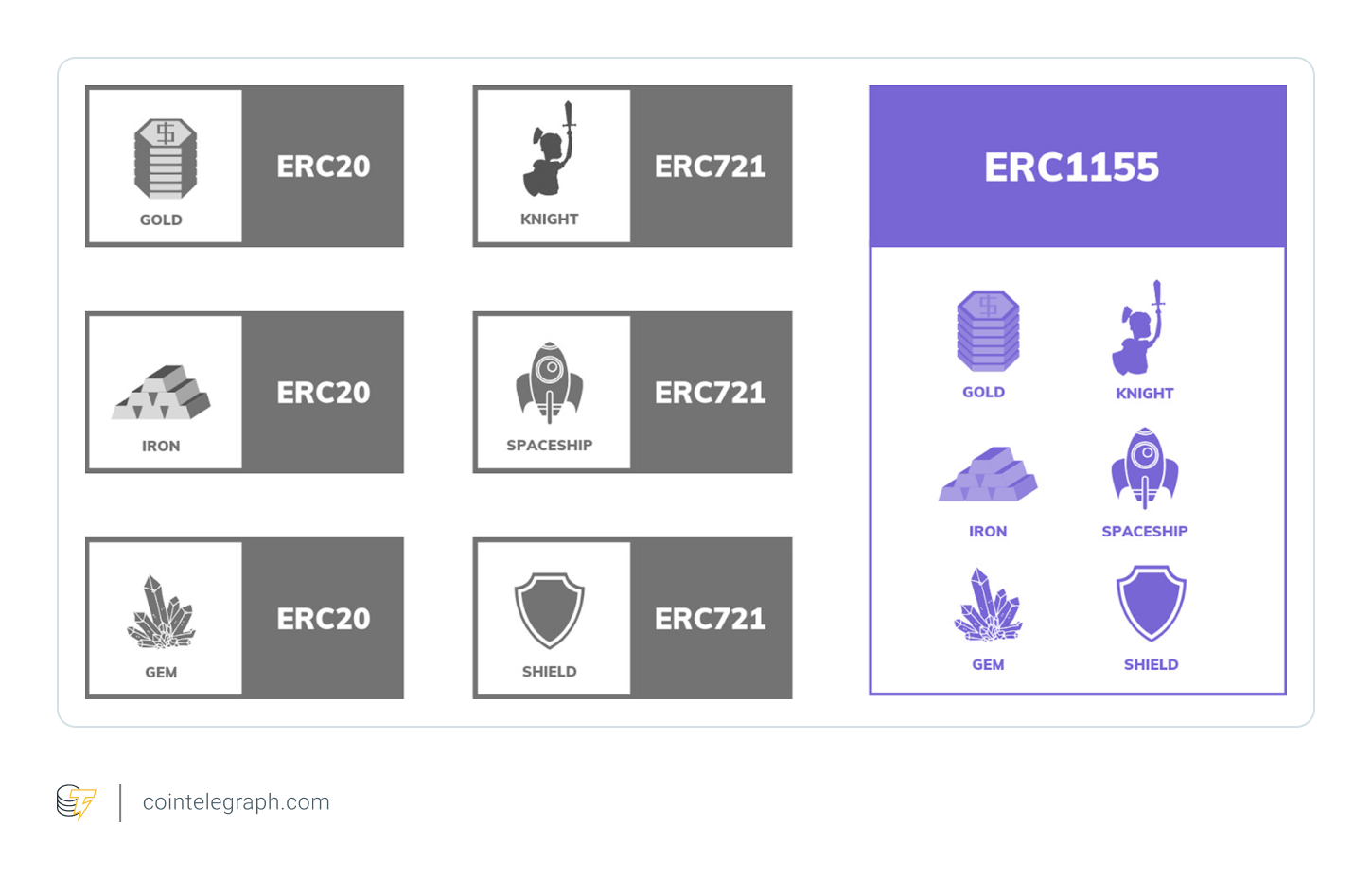Key takeaways
- NFTs are digital assets representing ownership of unique items, verified and stored on a blockchain.
- SFTs combine the features of fungible and non-fungible tokens. They transform into unique, non-fungible assets under certain conditions — such as after usage or redemption.
- NFTs dominate in rarities and collectibles, while SFTs are ideal for interchangeability and uniqueness.
- SFTs offer versatility, cost efficiency, and broader market appeal by seamlessly transitioning between fungible and non-fungible roles.
Have you ever wondered how non-fungible tokens (NFTs) stack up against their newest sibling, semi-fungible tokens (SFTs)? NFTs revolutionized digital ownership by introducing unique, indivisible assets into the blockchain ecosystem.
With the advent of SFTs, a new layer of utility has entered the space, blurring the lines between fungibility and exclusivity.
Here’s a comprehensive guide covering key differences between NFTs and SFTs, their key aspects and use cases.
What are NFTs and SFTs?
NFTs represent unique assets on a blockchain, each with distinct metadata that sets them apart. They are digital assets that use blockchain technology to certify ownership and authenticity.
Unlike cryptocurrencies, which are interchangeable, NFTs are unique and non-interchangeable. They represent ownership of a specific digital component — art, music, in-game items or even virtual real estate.
What makes NFTs revolutionary is their ability to provide proof of ownership in the digital world, where replication is typically effortless. For instance, Beeple’s digital artwork Everydays: The First 5000 Days sold for a staggering $69 million, signaling the potential for digital art to compete with traditional masterpieces.
NFTs go beyond art — they are also making waves in gaming, fashion, clothing and more. Their potential lies in granting creators new revenue streams while allowing buyers to support and own a piece of digital culture. For example, owning a particular CryptoPunk or Bored Ape NFT means you hold something singularly valuable.
SFTs, on the other hand, are tokens that can be both fungible and non-fungible during their lifecycle. They start as fungible tokens but become non-fungible after specific conditions are met, like redemption or usage. They are often employed in gaming and event tickets, where fungibility is necessary initially but transforms to track individual ownership or usage later.
ERC-1155 is the SFT token standard on the Ethereum blockchain. It enables a single smart contract to contain both fungible and non-fungible tokens offering multi-token support, batch transfers, enhanced security and blockchain efficiency optimization.

ERC-1155 combines the functionality of both the ERC-20 and ERC-721 standards while enabling the transfer of fungible and non-fungible tokens in a single transaction.

Did you know? The concept of NFTs originated with Bitcoin-based colored coins around 2012-2013. However, the first NFT, “Quantum”, was minted in 2014 on the Namecoin blockchain by Kevin McCoy and Anil Dash. McCoy sold it for $4 during a live presentation for the Seven on Seven conferences at the New Museum in New York City. McCoy and Dash referred to the technology as “monetized graphics.”

How do NFTs and SFTs differ?
Understanding the differences between NFTs and SFTs is essential to grasp their respective use cases and how they cater to different blockchain applications. While both are digital assets powered by blockchain, their fungibility, applications and market behavior set them apart.
Fungibility
- NFTs are inherently non-fungible, making each token unique.
- SFTs are hybrid; they maintain fungibility initially but can convert into non-fungible assets under predefined conditions.
Applications
- NFTs dominate in art, music and digital collectibles.
- SFTs excel in gaming, ticketing and scenarios needing a mix of interchangeability and uniqueness, such as in-game currencies or items that become unique after acquisition.
Market behavior
- NFT value is typically subjective, tied to the rarity or desirability of individual tokens.
- SFT value is influenced by their initial fungibility, making them more liquid in the early stages.
Imagine a concert ticket system. General admission tickets could begin as fungible tokens (SFTs), but a VIP upgrade might transform them into unique, non-fungible passes with perks like backstage access — blurring the lines between NFT and SFT utility.
This adaptability of SFTs makes them a compelling innovation in blockchain technology, complementing the uniqueness of NFTs.

Did you know? In blockchain games like Splinterlands and Gods Unchained, base-level cards could be issued as SFTs, evolving into unique NFTs when upgraded — saving cost and complexity.
Benefits of SFTs over NFTs
Let’s understand what benefits are offered by SFTs over NFTs:
Versatility
SFTs adapt to both fungible and non-fungible roles, making them more flexible for multi-phase applications. One minute, they’re fungible and interchangeable, like in-game cash. Next, they’re rare and personalized, like a weapon tailored to your play style. It’s this versatility that gives them an edge.
Imagine playing your favorite game. That pile of gold coins you earned? Totally interchangeable with someone else’s. But then — boom! — you upgrade to a legendary sword that’s yours and yours alone. That’s SFT magic in action.
This ability to seamlessly transition between roles also offers developers more creative freedom to design dynamic ecosystems. In contrast, NFTs are locked into their non-fungible identity from creation, limiting their adaptability in multi-phase projects.
Cost efficiency
By starting as fungible tokens, SFTs simplify the initial distribution process, often reducing associated costs.
This can significantly reduce minting and transactional costs compared to NFTs, which require individual creation and verification for each token. For example, in a ticketing system, a batch of SFTs can be minted and distributed as standard tickets, keeping costs low, before selectively transforming into premium NFTs for VIP access. This makes SFTs especially appealing for large-scale deployments.
Broader market appeal
Their dual functionality appeals to a wider user base, from gamers to event organizers.
Consider a blockchain-based e-commerce platform. SFTs could be used to issue standard coupons or reward points (fungible phase), which are easily transferable among users. As customers redeem these points, they could evolve into unique tokens representing personalized rewards, such as exclusive discounts or tailored offers. This dynamic utility allows SFTs to drive user engagement and enhance customer experiences.
The hybrid design of SFTs ensures they can serve as an “all-in-one” token for many ecosystems, reducing barriers to entry and broadening their use cases. By combining the strengths of fungible tokens (ease of distribution) and non-fungible tokens (uniqueness), SFTs provide a compelling solution for real-world applications where adaptability, efficiency and scalability are critical.
Future prospects of NFTs and SFTs
The lines between NFTs and SFTs continues to blur as blockchain technology evolves. Both token types will play significant roles in advancing tokenization, with NFTs driving exclusivity and SFTs enhancing scalability and accessibility.
Whether you are an artist, gamer or blockchain enthusiast, understanding these differences helps you navigate this dynamic landscape and capitalize on emerging opportunities. The question isn’t just NFTs vs. SFTs, but how these technologies can coexist and complement each other in the decentralized world.
Written by Shailey Singh


